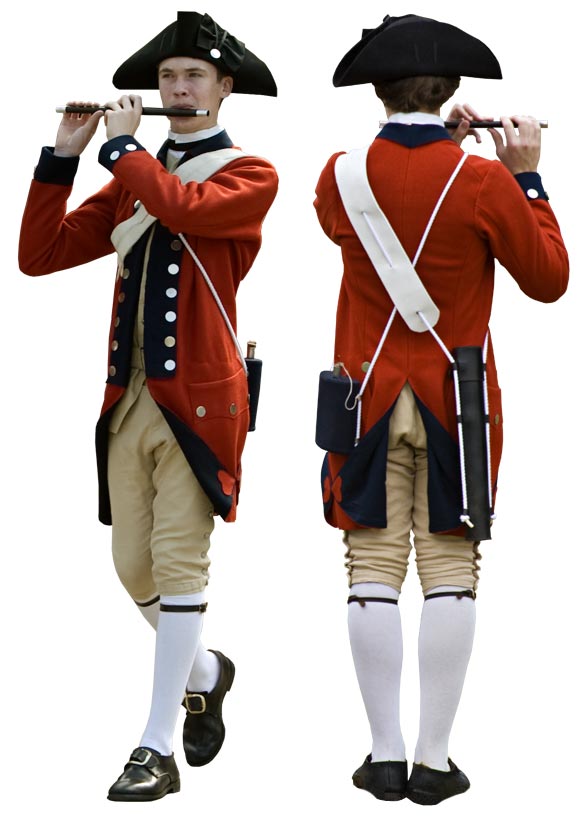Page content
Anatomy of the Red Regimental Uniform
Roll over image to view descriptions of the dress uniform worn by the Virginia State Garrison Regiment. See glossary of terms.

- Hat
- Tri-cornered hats are cocked at a military angle, centered over the left eye.
- Cockade
- An ornamental cockade is worn on the left. Today’s Fifes and Drums wear an all-black cockade, but styles and usage varied throughout the war.
- Collar
- A stock made of leather allowed soldiers to maintain the high, stiff-necked fashion without the trouble of washing and pressing a linen one in the field.
- Regimental coat
- Fifers and drummers wear the same coat as other units do, but with one critical difference: the colors worn by the musicians are the reverse of their fighting brothers’, indicating their non-combat status. This coat’s pattern is based on an antique enlisted man’s coat in the National Army Museum.
- Canteen
- One-quart canteens were issued to each soldier. A sling strap held the vessel ready at the left hip. Most canteens were small wooden casks, but some were made of tin or glass.
- Coat Tails
- Coat tails are turned back to allow freedom of movement. The heart decoration is based on a British example, and also serves to reinforce the hook and eye closure.
- Breeches
- Buff-colored linen or wool breeches are fitted across the front and roomy in the seat. Waistcoat and breeches are known as small clothes.
- Garters
- Garters were traditionally worn by officers, and not the enlisted ranks. Colonial Williamsburg’s modern-day corps is issued garters for the expedient of securing stockings on young corps members' calves.
- Stockings
- White knitted stockings of wool, linen, or cotton protected the lower leg.
- Shoes
- Black leather shoes fastened with polished brass buckles are worn by every member of today’s Fifes and Drums.
- Waistcoat
- A single breasted sleeveless waistcoat would have been made of linen broadcloth and fastened with 12 buttons. Waistcoat and breeches are known as small clothes.
- Buttons
- Eighteenth-century buttons would have been pewter, but that metal’s soft quality makes buttons too easily marred for use in Colonial Williamsburg’s Fifes and Drums, who now use a harder white metal.
- Belt
- A fighting soldier’s belt might have been fitted with a frog to carry his bayonet or sword, but here simply holds a musician’s waistcoat closed.
- Shoulder belt
- The field music fifer uses this strap to carry a fife; a fighting unit would have slung a cartridge box from it.
- Cuffs
- The cuffs on a musician’s sleeve are decorative, since a functioning one would hinder them in playing their instruments.
- Fife
- The Revolutionary-era fife was an instrument designed to be heard over miles and through the din of battle. Most were made of boxwood or another hard wood, but some metal examples have been recovered.